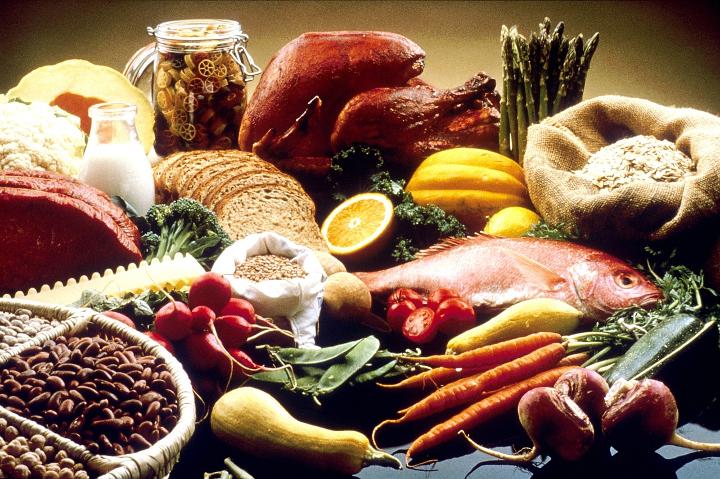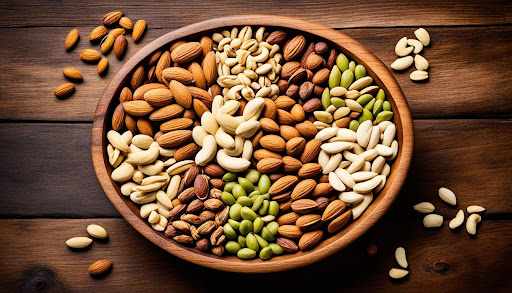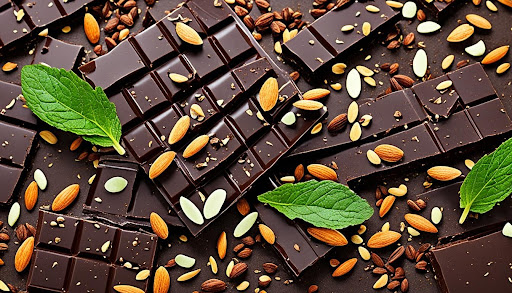What Foods Are Rich in Magnesium? Top Sources Explored

Ever wondered what foods are packed with magnesium? This mineral is key for strong muscles, nerves, bones, and steady blood sugar. Shockingly, more than a third of adults in the Netherlands fall short on their daily magnesium.[1] But fear not, many foods are full of magnesium; adding them to your diet can boost your health.
You can find magnesium in a broad range of foods. Think leafy greens, legumes, nuts, seeds, and whole grains. Surprisingly, the Netherlands gets most of its magnesium from cereals and non-alcoholic drinks like coffee and water.[1] So, from nutritious pumpkin seeds to delightful avocados, you have plenty of options to increase your magnesium intake.
Key Takeaways:
-
Magnesium is an essential mineral that plays a crucial role in many bodily functions.
- Over 1 in 3 Dutch adults do not get enough magnesium daily.
- The best dietary sources of magnesium include nuts, seeds, leafy greens, legumes, and whole grains.
- Specific magnesium-rich foods include pumpkin seeds, chia seeds, almonds, spinach, and avocados.
- Incorporating a variety of magnesium-rich foods into your diet can help you meet your daily needs.
The Importance of Magnesium
Magnesium is a key mineral for over 300 body functions.[1] It helps keep our hearts beating right and our muscles working well. Magnesium also helps control our blood pressure, keeps our bones strong, and powers our bodies.[1]
We should aim to get 310 to 420 mg of magnesium every day, depending on our age and gender.[2] Sadly, more than 1 in 3 adults in Australia misses this target.[1]
Magnesium's Role in Essential Body Processes
Magnesium has many important jobs in our bodies.[1] It keeps our hearts beating in rhythm and our muscles moving. Magnesium is also crucial for setting our blood pressure right.[1]
Additionally, it helps to keep our bones and teeth strong. It's essential for our bodies to make energy, too.[1]
Consequences of Magnesium Deficiency
Not getting enough magnesium for a long time can lead to serious health issues.[1] This includes heart problems, diabetes, and weak bones. Luckily, most kids in Australia get the magnesium they need.[1]
But for some with low magnesium levels or health problems, supplements might be needed.[1]
What Foods Are Rich in Magnesium?
Magnesium is a mineral found in many foods. Foods with lots of fiber are also rich in magnesium. Eat plenty of leafy greens, legumes, nuts and seeds, whole grains, low-fat dairy, fruits, and veggies.[1] You'll find different amounts of magnesium in these foods. For example, milk has 24 mg in one cup, but 30g of pumpkin seeds has 156 mg.[1]
Eating a mix of magnesium-rich foods daily helps you get enough magnesium. The best food sources for magnesium include:
- Pumpkin seeds: 156 mg of magnesium per 30g serving[1]
- Chia seeds: 111 mg of magnesium per 30g serving[1]
- Almonds: 80 mg of magnesium per 30g serving[1]
- Spinach: 78 mg of magnesium per 1/2 cup, when boiled[1]
- Cashews: 74 mg of magnesium per 30g serving[1]
- Peanuts: 63 mg of magnesium per 1/4 cup serving[1]
- Soy milk: 61 mg of magnesium per 1 cup[1]
- Rolled oats: 29 mg of magnesium per 100g, cooked in unsalted water[1]
- Whole wheat bread: 46 mg of magnesium in 2 slices[1]
- Avocado: 44 mg of magnesium per 1 cup, cubed[1]
- Brown rice: 42 mg of magnesium per 1/2 cup, cooked[1]
- Milk: 24 mg of magnesium per 1 cup serving[1]
Add these top magnesium-rich foods to your meals. This will help you get the magnesium you need and keep your body healthy.[1],[3],[4]
Seeds: Nutrient-Dense Powerhouses
Nuts and seeds, though small, are full of important nutrients. They provide protein, fiber, healthy fats, and key minerals. Some seeds stand out for their high magnesium content.[5]
Flaxseeds: A Magnesium Heavyweight
Flaxseeds are rich in magnesium, with 392 mg per 100g. They add a nutty flavor to dishes. They're great in smoothies, yogurt, or baked items.[6]
Chia Seeds: Packed with Plant-Based Magnesium
Chia seeds are magnesium powerhouses with 335 mg per 100g. These tiny seeds boost magnesium in salads, oatmeal, and baked goods.[6]
Pumpkin Seeds: A Crunchy Magnesium Boost
Roasted pumpkin seeds give 150 mg of magnesium per ounce. They're also high in plant-based protein. Pumpkins seeds make a healthy snack or meal addition.[5]
Nuts: Convenient and Nourishing
Nuts are a top pick for boosting magnesium in your diet. They're easy to carry, making them a go-to snack. Plus, they're full of this vital mineral.[7]
Almonds: A Versatile Magnesium Source
Almonds stand out as a rich magnesium source, offering 270mg per 100g.[7] They're perfect for meeting your daily magnesium requirement. You can eat almonds as they are, in salads, or in smoothies.
Cashews: Creamy and Magnesium-Rich
Cashews shine, too, with 250mg of magnesium per 100g.[7] Their creamy taste works well in many dishes. Adding them to meals and snacks boosts your magnesium.
Enjoying almonds and cashews more enhances your magnesium intake. They're not just tasty but also good for you.[7],[2]

Legumes: Plant-Based Protein and Magnesium
Legumes are full of vital nutrients like plant-based protein, fiber, and magnesium.[8] They are key in helping our bodies work better. From keeping our bones strong to aiding in heart health and energy, magnesium is essential.[8]
Edamame: A Soy-Based Magnesium Delight
Edamame, young soybeans, offer a lot of magnesium. For example, a 1/2 cup of edamame gives you 50 mg of this mineral. It's a great choice to add magnesium to your diet.[2]
Peanuts: Not Just a Nut, but a Legume
Even though they seem like nuts, peanuts are actually legumes. They're a fantastic source of magnesium too. Eating just a 1/4 cup of peanuts gives you 63 mg of magnesium, helping meet your daily needs.[2]
Adding peanuts to your diet, in snacks or recipes, is a delicious way to increase magnesium intake. It's easy and yummy!
Green Leafy Vegetables: Nutritional Superstars
Dark and leafy greens are like superheroes for our health, thanks to magnesium and more.[9] It's advised by the USDA that anyone over 9 should eat one and a half to two cups of these greens each week.[9] They are low in calories, 10 to 25 per half cup, but high in vitamins and minerals.[9] This includes vitamin A, vitamin C, antioxidants, and much more.[9]
Spinach: A Classic Magnesium-Packed Green
Spinach has many nutritional benefits. Spinach is a top choice for getting your magnesium dose.[10] It contains 78 mg of magnesium in just 1/2 cup, a good amount of this health-boosting mineral.[10] Spinach is also rich in potassium, with 840 mg in one cooked cup, aiding in your daily goal set by the USDA.[10]
Swiss Chard: A Leafy Magnesium Powerhouse
Swiss chard is another green that helps us meet our magnesium needs, offering 75 mg per 1/2 cup.[10] It's full of essential vitamins and minerals like A, C, and K, plus calcium and iron.[9]
Adding more leafy greens such as spinach and Swiss chard to your meals is an excellent way to increase your magnesium levels and improve your health overall.[10] Cooked veggies are easier for your body to take in than raw ones, providing essential nutrients in a different way.[10]
Whole Grains: Fiber and Magnesium Combined
Whole grains are packed with fiber and magnesium, which makes them key for your health. Adding more whole grains to what you eat helps raise magnesium in your body. This supports your health overall.
Quinoa: A Gluten-Free Magnesium Source
Quinoa is a gluten-free whole grain that's full of magnesium.[2] A half-cup of cooked quinoa has 60 mg of magnesium. It's perfect for upping your intake of this vital mineral.
Brown Rice: A Wholesome Magnesium Option
Brown rice is rich in magnesium, too.[2] Half a cup of cooked brown rice gives you 42 mg of magnesium. It's a great, healthy way to get more magnesium in your meals.
Eating more whole grains like quinoa and brown rice helps you get more magnesium.[3] They are rich in fiber and good for your health in many ways.
Dark Chocolate: A Decadent Magnesium Treat
Dark chocolate is not only delightful but also a smart way to get more magnesium in our diet.[11] It contains 41 to 64 mg of magnesium per ounce (30 grams) when its cacao is 70% or more. This helps lower blood pressure and ease anxiety.[11] A 28-gram serving of 80% dark chocolate gives you 16% of your daily magnesium needs.[12]
Choosing organic dark chocolate with high cocoa content is best for getting more magnesium and other key nutrients.[11] Some makers use coconut sugar, making it a good option without refined sugar.[11] You should eat 1 to 2 ounces (30 to 60g) of dark chocolate a day. But remember, dark chocolate is high in calories and saturated fat, so enjoy more sparingly.[11]
Eating this decadent treat helps us meet our magnesium needs. It also supports our general health and well-being.[11]

Fruits and Vegetables: Additional Magnesium Sources
Nuts, seeds, and whole grains are great for magnesium. But, don't forget about fruits and vegetables. Avocados, bananas, and potatoes are top picks for magnesium.[2]
Avocados: A Creamy Magnesium Delight
Avocados are creamy and full of magnesium. Eat one and you'll get 58 mg of magnesium, 14% of what you need in a day.[2] Put avocados in salads, sandwiches, or enjoy them alone as a snack to get more magnesium.
Bananas: A Convenient Magnesium Snack
Looking for something quick and magnesium-rich? Try a banana. It has 32 mg of magnesium, 9% of your daily dose.2 Bananas are great on their own, in smoothies, or in baked goods for extra magnesium.
Potatoes: A Versatile Magnesium-Rich Vegetable
Potatoes with the skin are packed with magnesium. A medium one gives you 48 mg, 11% of your DV.[2] Enjoy potatoes in many dishes to up your magnesium intake.
Adding these magnesium-rich foods to your meals will help you get more of this vital mineral. This supports your health and well-being.
Water: A Surprising Magnesium Source
Most of the magnesium we get comes from food. But, did you know magnesium in water is also key?[4] Different waters have varying magnesium levels. By drinking 2 liters daily, you might consume as much as 240 mg of magnesium from water.[4]
Water's magnesium level changes based on its source and how it's treated. Some sources are rich in magnesium, some aren't. Opting for water high in magnesium can increase your daily intake significantly, meeting your body's needs.[4]
| Magnesium-Rich Water Sources | Magnesium Content (per 2 liters) |
| Mineral water | 120-240 mg |
| Tap water (varies by location) | 40-120 mg |
| Bottled water (varies by brand) | 20-100 mg |
Adding magnesium in water to your daily intake is simple. It enhances your magnesium consumption, benefiting your health and well-being.[4]
Conclusion
Eating a mix of magnesium-rich foods can help us get the magnesium we need each day. Foods like nuts, seeds, and dark leafy greens are filled with magnesium. Plus, adding whole grains and fruits and vegetables helps us, too.[13],[14]
Spinach, pumpkin seeds, and dark chocolate are great sources of magnesium. So are black beans and almonds. These foods can give us a big part of the magnesium we should have every day.[13],[14]
Choosing a wide range of nutrient-dense foods is the key. It makes it easy to get all the magnesium we need. This way, we might not even need supplements.[15] However, some of us might have gaps in our diet. In that case, a top-quality magnesium supplement like Healthy Metal's Magnesium could be very helpful. It can boost our health and well-being.